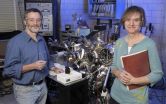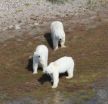(Press-News.org) BATON ROUGE – Genetic diseases impact millions around the world each and every day. Complex medical conditions with genetic predispositions, such as hypertension, can also weigh heavily on our lives. Susceptibility to hypertension has many genetic components and often goes undiagnosed until a person has signs of advanced disease.
Many imagine a day when science will give us the tools to discover how to work with these genetic issues and discover ways to not only diagnose, but to use them to our advantage as individuals. LSU Boyd Professor Mark Batzer and an international consortium of hundreds of the world's best and brightest experts have come together to tackle the 1,000 Genomes Project, which aims to provide a deep understanding of human genome sequence variation. It will be a foundation for investigating the relationship between genotypes – coded, internal information stored in our genes – and phenotypes, the outward expressions of those genes. Moreover, the 1,000 Genomes Project will contribute to our understanding of the impact of non-coding sequences and identify areas of high variation with the human population. The pilot study, "A map of human genome variation from population-scale sequencing," is complete with detailed analyses of the first 185 genomes sequenced and will be published on Oct. 28 in the prestigious scientific journal Nature.
"This is the biggest study of human variation and diversity ever attempted," Batzer said, one of the principal investigators in the group. "The pilot project helped us to develop our methodology and to really get a scope on the breadth of human variation."
Batzer said that so far, the group had discovered far more variability within the human genome than was ever expected. Though the pilot study only reports the analysis of the first 185 sequenced genomes, the group is currently more than halfway to their overall goal of 2,500 genome sequences.
The first human genome was sequenced through the Human Genome Project, began in 1990, when the National Institutes of Health, or NIH, joined with the Department of Energy to develop an international research group capable of sequencing all 3 billion base pairs of a human genome. The project, though successful, wasn't completed until 2003 – nearly 13 years later.
"That's part of what makes the 1,000 Genomes Project such a landmark study. It really does usher us into the age of personal genomics," Batzer said. "We've gone from taking more than a decade to sequence a genome to being able to sequence about 1,000 in just a few years, and for considerably less cost."
And the value of these projects is immense, since learning more about human genetic variability is inevitably tied to our understanding of disease susceptibility, inheritance and mutational processes, thus directly impacting human health.
According to Batzer, the full study will give more insight into the heredity of genomic traits, whether positive or negative. It will allow scientists to understand where parts of our genomes are changing, how fast and perhaps why. It will also offer the opportunity in the not-so-distant future for testing the genomic predisposition of passing on certain disorders to future generations to and to gain new insight into the genetic basis of these disorders.
"Personal genomics? This was just a pipedream a few years ago," Batzer said. "Now, we're changing the ballgame. There are so many disorders that would be able to be diagnosed and impacted with this technology once it's completely developed."
The project involves several hundred scientists from all over the world. Simply coordinating research efforts was a significant undertaking.
"It's been a true pleasure to work with all these amazing scientists from around the world. Getting to know them and exchanging ideas while working on a project this big and this important is one of the highlights of my career," Batzer said. "LSU is playing a significant role in taking the world to the next step in genomics, and I don't think we're very far removed from seeing those results start to show up in our day-to-day lives."
INFORMATION:
Related Links
Mark Batzer's Research Lab
batzerlab.lsu.edu
National Human Genome Research Project
www.genome.gov
1,000 Genomes Project
www.1000genomes.org
LSU researcher participates in NIH-funded study ushering in the age of personal genomics
Huge international group to map genomes of 2,500 people in order to understand human genetic variability
2010-11-05
ELSE PRESS RELEASES FROM THIS DATE:
NASA satellite data confirm a stronger Tropical Storm Tomas, hurricane warnings up
2010-11-05
NASA's infrared satellite imagery has confirmed that Tomas is intensifying as convection is strengthening and cloud tops within the system are getting colder.
Infrared imagery helps scientists detect cold top temperatures within a tropical cyclone, and Tomas' cloud tops have grown colder over the last 24 hours. Tomas showed strong convective activity in his center as indicated by high thunderstorms that were as cold as -63 degrees Fahrenheit. The colder the cloud tops, the higher and stronger the thunderstorms are that power the tropical cyclone. The infrared imagery ...
More talk, less agreement: Risk discussion can hurt consensus-building on science/technology
2010-11-05
When it comes to public issues pertaining to science and technology, "talking it out" doesn't seem to work. A new study from North Carolina State University shows that the more people discuss the risks and benefits associated with scientific endeavors, the more entrenched they become in their viewpoint – and the less likely they are to see the merit of other viewpoints.
"This research highlights the difficulty facing state and federal policy leaders when it comes to high-profile science and technology issues, such as stem cell research or global warming," says Dr. Andrew ...
Pennycress could go from nuisance weed to new source of biofuel
2010-11-05
A common roadside plant could have the right stuff to become a new source of biofuel, according to U.S. Department of Agriculture (USDA) studies.
Scientists with the Agricultural Research Service (ARS), USDA's principal intramural scientific research agency, have found that field pennycress yields impressive quantities of seeds whose oil could be used in biodiesel production.
Field pennycress belongs to the Brassicaceae family, along with canola, camelina and mustard—other prolific producers of oil-rich seeds. The ARS studies help support USDA's efforts to develop ...
Iowa State, Ames Laboratory scientists advance the understanding of the big getting bigger
2010-11-05
AMES, Iowa – Patricia Thiel of Iowa State University and the Ames Laboratory put a box of tissues to the right, a stack of coasters to the middle and a trinket box to the left.
"Nature," she said of her table-top illustration, "doesn't want lots of little things." So Thiel grabbed the smaller things and slid them into a single pile next to the bigger tissue box. "Nature wants one big thing all together, like this."
Thiel, an Iowa State Distinguished Professor of Chemistry and a faculty scientist for the U.S. Department of Energy's Ames Laboratory, and James Evans, an ...
Global food safety: Keeping food safe from farm to table
2010-11-05
Washington, DC – November 2, 2010 – Food safety problems can arise at any of multiple stages of food production, and illnesses that result from them are frequently not detected or reported, according to a new report from the American Academy of Microbiology.
The report, "Global Food Safety: Keeping Food Safe from Farm to Table," is based on a colloquium convened by the Academy in 2009. Colloquium participants with expertise in microbiology, public health, food science, and economics reviewed the current state of affairs in microbiological food safety around the world.
The ...
Gene identified for spread of deadly melanoma
2010-11-05
AUDIO:
Researchers at Washington University School of Medicine in St. Louis have identified a gene linked to the spread of melanoma of the eye. Although more research is needed, the researchers...
Click here for more information.
Researchers at Washington University School of Medicine in St. Louis have identified a gene linked to the spread of eye melanoma.
Although more research is needed, the researchers say the discovery is an important step in understanding why some ...
Missouri Botanical Garden researchers discover 8 new species in Boliva national parks
2010-11-05
(ST. LOUIS): Botanists at the Missouri Botanical Garden have described eight new plant species collected in the Madidi National Park and surrounding areas located on the eastern slopes of the Andes in northern Bolivia. The new species are from several different genera and families and are published in a recent edition of the Missouri Botanical Garden journal Novon.
Missouri Botanical Garden scientists and colleagues from the National Herbarium in La Paz, Bolivia describe Prestonia leco, Passiflora madidiana, Siphoneugena minima, Siphoneugena glabrata, Hydrocotyle apolobambensis, ...
Polar bears can't eat geese into extinction
2010-11-05
As the Arctic warms, a new cache of resources—snow goose eggs—may help sustain the polar bear population for the foreseeable future. In a new study published in an early online edition of Oikos, researchers affiliated with the Museum show that even large numbers of hungry bears repeatedly raiding nests over many years would have a difficult time eliminating all of the geese because of a mismatch in the timing of bear arrival on shore and goose egg incubation.
"There have been statements in popular literature indicating that polar bears can extirpate snow geese quickly ...
Pigs reveal secrets: New research shines light on Quebec industry
2010-11-05
Which are the best pieces of pork, what their texture is, how moist they are – the secrets pigs keep from even the most skilled butchers – are about to be revealed, thanks to a sophisticated new technique that has been developed by McGill University researchers in conjunction with Agriculture Canada and the pork industry. "This is about giving industry workers better tools to do their job," explained Dr. Michael Ngadi of McGill's Department of Bioresource Engineering. "Computer-aided analysis of meat will result in higher-quality jobs, optimal production, and exports that ...
Hard work improves the taste of food, Johns Hopkins study shows
2010-11-05
It's commonly accepted that we appreciate something more if we have to work hard to get it, and a Johns Hopkins University study bears that out, at least when it comes to food.
The study seems to suggest that hard work can even enhance our appreciation for fare we might not favor, such as the low-fat, low calorie variety. At least in theory, this means that if we had to navigate an obstacle course to get to a plate of baby carrots, we might come to prefer those crunchy crudités over the sweet, gooey Snickers bars or Peanut M&Ms more easily accessible via the office vending ...
LAST 30 PRESS RELEASES:
Drone sampling of whale breath reveals first evidence of potentially deadly virus in Arctic
Roman soldiers defending Hadrian’s Wall infected by parasites, study finds
Pinochet’s prisoners were tormented with music but still found solace in it, a new book reveals
Fertility remains high in rural Tanzania despite access to family planning
AI-assisted device can improve autism care access
Kinetic careers
Uncovering how parasitic plants avoid attacking themselves to improve crop resistance
Nanoparticle vaccine strategy could protect against Ebola and other deadly filoviruses
Study finds brain care score can predict risk of stroke across racial groups
Key lung immune cells can intensify allergic reactions
Do hormones explain why women experience more gut pain?
New materials conduct ions in solids as easily as in liquids
Breakthrough of the Year: Renewable energy begins to eclipse fossil fuel-based sources
LLM use is reshaping scientific enterprise by increasing output, reducing quality and more
Introducing LightGen, a chip for ultra-fast, ultra-efficient generative AI
Astronomers see fireworks from violent collisions around nearby star
ACC/AHA issue new guideline on managing congenital heart disease in adults
Cosmic crash caught on camera
Is talented youth nurtured the wrong way? New study shows: top performers develop differently than assumed
Ants: An untapped resource in the development of antibiotics?
Archaeologists use AI to create prehistoric video game
Mitochondria migrate toward the cell membrane in response to high glucose levels
Tiny viral switch offers hope against drug-resistant bacteria
Most parents aware of early peanut introduction guidelines, but confused about details
HPV vaccine can protect against severe lesions of the vulva and vagina
Virtual care provision and emergency department use among children and youth
Quadrivalent HPV vaccine and high-grade vulvovaginal lesions
Insights into dry eyes gained from stem cell-derived tear glands
Researchers identify 166 human pluripotent stem cell lines available for use in clinical applications
Europa Clipper instrument uniquely observed interstellar comet 3I/ATLAS
[Press-News.org] LSU researcher participates in NIH-funded study ushering in the age of personal genomicsHuge international group to map genomes of 2,500 people in order to understand human genetic variability




